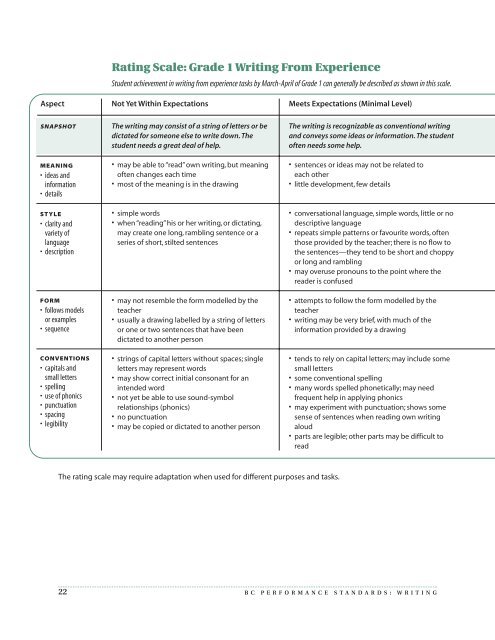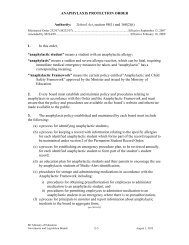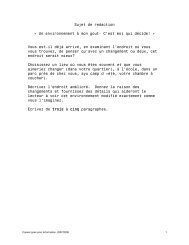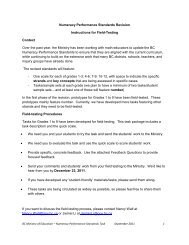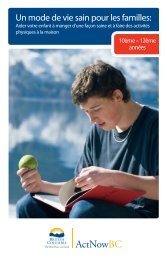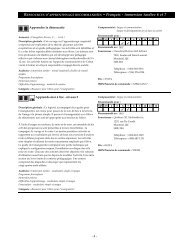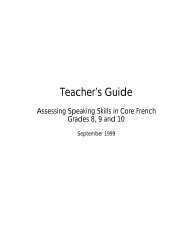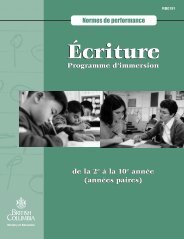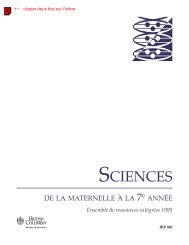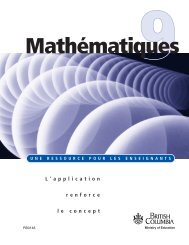BC Performance Standards - Writing - Grade 1
BC Performance Standards - Writing - Grade 1
BC Performance Standards - Writing - Grade 1
You also want an ePaper? Increase the reach of your titles
YUMPU automatically turns print PDFs into web optimized ePapers that Google loves.
Rating Scale: <strong>Grade</strong> 1 <strong>Writing</strong> From Experience<br />
Student achievement in writing from experience tasks by March-April of <strong>Grade</strong> 1 can generally be described as shown in this scale.<br />
Aspect Not Yet Within Expectations Meets Expectations (Minimal Level)<br />
SNAPSHOT<br />
MEANING<br />
• ideas and<br />
information<br />
• details<br />
STYLE<br />
• clarity and<br />
variety of<br />
language<br />
• description<br />
FORM<br />
• follows models<br />
or examples<br />
• sequence<br />
CONVENTIONS<br />
• capitals and<br />
small letters<br />
• spelling<br />
• use of phonics<br />
• punctuation<br />
• spacing<br />
• legibility<br />
The writing may consist of a string of letters or be<br />
dictated for someone else to write down. The<br />
student needs a great deal of help.<br />
• may be able to “read” own writing, but meaning<br />
often changes each time<br />
• most of the meaning is in the drawing<br />
• simple words<br />
• when “reading” his or her writing, or dictating,<br />
may create one long, rambling sentence or a<br />
series of short, stilted sentences<br />
• may not resemble the form modelled by the<br />
teacher<br />
• usually a drawing labelled by a string of letters<br />
or one or two sentences that have been<br />
dictated to another person<br />
• strings of capital letters without spaces; single<br />
letters may represent words<br />
• may show correct initial consonant for an<br />
intended word<br />
• not yet be able to use sound-symbol<br />
relationships (phonics)<br />
• no punctuation<br />
• may be copied or dictated to another person<br />
The writing is recognizable as conventional writing<br />
and conveys some ideas or information. The student<br />
often needs some help.<br />
• sentences or ideas may not be related to<br />
each other<br />
• little development, few details<br />
• conversational language, simple words, little or no<br />
descriptive language<br />
• repeats simple patterns or favourite words, often<br />
those provided by the teacher; there is no flow to<br />
the sentences—they tend to be short and choppy<br />
or long and rambling<br />
• may overuse pronouns to the point where the<br />
reader is confused<br />
• attempts to follow the form modelled by the<br />
teacher<br />
• writing may be very brief, with much of the<br />
information provided by a drawing<br />
• tends to rely on capital letters; may include some<br />
small letters<br />
• some conventional spelling<br />
• many words spelled phonetically; may need<br />
frequent help in applying phonics<br />
• may experiment with punctuation; shows some<br />
sense of sentences when reading own writing<br />
aloud<br />
• parts are legible; other parts may be difficult to<br />
read<br />
* Student performance that falls within the wide range of expectations for <strong>Grade</strong> 1 by March-April generally matches the Level 2 descriptions in<br />
The rating scale may Evaluating require <strong>Writing</strong> adaptation Across Curriculum. when used for different purposes and tasks.<br />
22 20<br />
<strong>BC</strong> bc PERFORMANCE PerFormance standards: STANDARDS: writing<br />
WRITING


